WSEAS Post Conference Report, September 2006, Lisbon, Portugal (55 images)
What a great success!
The following important WSEAS events passed in the brilliant history
of our society:
Lisbon, Portugal, September 22-24, 2006
Lisbon, Portugal, September 22-24, 2006
You can see the program, plenary lectures and the papers from the web.
Conference Statistics:
Submitted papers: 619
Accepted papers: 312
Click a picture to see a larger view-->
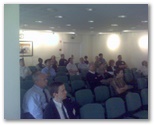
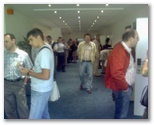
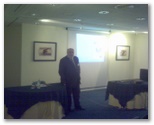
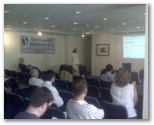

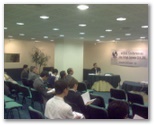
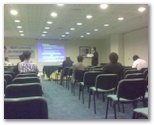
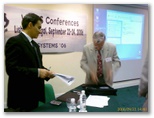
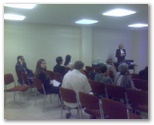
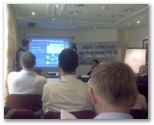
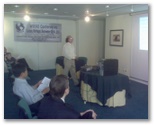
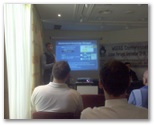
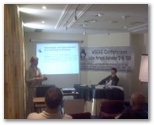
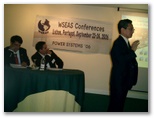
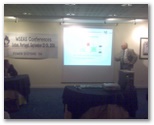
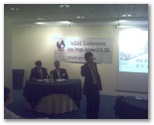
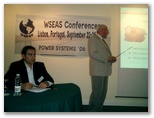
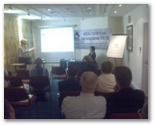
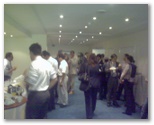
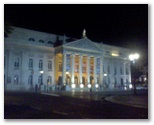
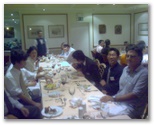
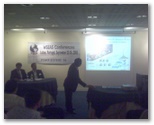
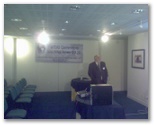

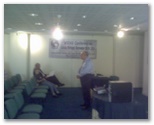
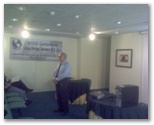
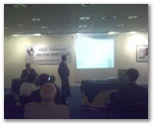
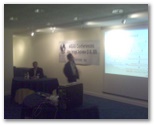






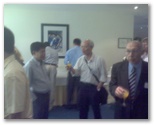
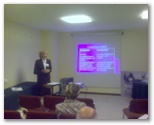
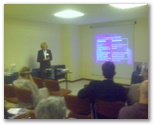
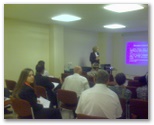

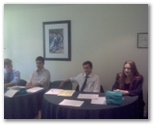
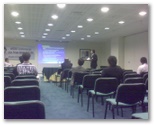

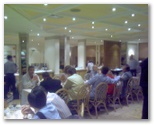
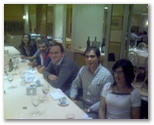





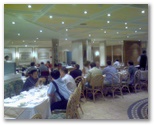




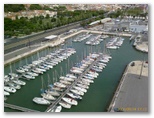
.: Location: About Lisbon:
Lisbon's position on seven low hills beside a river once lured traders and settlers, and it's still a stunning site. Add to that its cultural diversity, laid-back feel and architectural time warp, and you have one of the most enjoyable cities in Europe - and also one of the most economical.
At its heart are wide, tree-lined avenues graced by Art Nouveau buildings, mosaic pavements and street cafes. Seen from the river - one of the city's many great viewpoints - Lisbon is an impressionist picture of low-rise ochre and pastel, punctuated by church towers and domes.
The city is a mix of vibrant blue and white azulejos (painted tiles), cobblestoned laneways, wildly extravagant Manueline architecture, melancholy fado singing, funiculars, fun and more than a touch of the medieval. Elegant, pretty and with an appetite for life, Lisbon will seep into your soul until you too are filled with saudade for her.
.:Scientific Part
Review Process:
Each paper was reviewed at least by 2 independent reviewers. The WSEAS Secretariat sent each paper to 4 reviewers. Some papers received reviews from 4 different referees. The WSEAS Secretariat forwarded these comments by personalized emails to the responsible for the correspondence author. The full list of the reviewers will be available in the web page:
http://www.worldses.org/reviewers.htm
Only authors of those papers, which are found to have very positive response from 2 referees and which are modified sufficiently to take into account all the comments of (at least 2) referees of the conference are invited to send an extended version in the WSEAS Journals (WSEAS Transactions).
WSEAS sent a full report of the whole review process and the whole correspondence
to the following international indexes that have recognized officially the Validity and the Reputation
of the WSEAS Conferences: (see also: www.worldses.org/indexes )
Best Student Papers:
The Organizing Committee received the forms that the Session Chairmen filled in
after the end of their Sessions and after additional evaluation and discussion
decided the following.
The Criteria were
a) originality and scientific impact
b) good presentation
c) paper presented by a student
The results of this evaluation are:
The Best Student Paper Award for POWER SYSTEMS
was given to Mr. Chang Hsin Chien for the paper:
Evaluation of the Proximity Effect upon the Impedance Characteristics of Subsea
Power Transmission Cables
[Authors: Chang Hsin Chien, Richard Bucknall]
The Best Student Paper Award for SIMULATION, MODELLING AND OPTIMIZATION
was given to Mr. Tibor Takacs for the paper:
Guaranteeing Cost Minimax Strategies for Uncertain Discrete-Time Systems
[Authors: Eva Gyurkovics, Tibor Takacs]
The Best Student Paper Award for SIGNAL, SPEECH AND IMAGE PROCESSING
was given to Mr. Yahya Sowti Khiabani for the paper:
Optimal Design of DPCM Scheme for ECG Signal Handling
[Authors: H. B. Bahar, Y. S. Khiabani]
The Best Student Paper Award for MULTIMEDIA, INTERNET & VIDEO TECHNOLOGIES
was given to Mr. Yimin Yu for the paper:
Video Completion Based on Improved Belief Propagation
[Authors: Yimin Yu, Duanqing Xu, Chun Chen, Lei Zhao]
No student papers were awarded for the DIWEB conference.
Indexes:
PROCEEDINGS: The Proceedings related to the Conference
are covered by:
1. ISI (ISINET)
2. INSPEC (IET, former IEE)
3. CSA (Cambridge Scientific Abstracts)
4. ELSEVIER and Elsevier Bibliographic Database
5. ZENTRALBLATT
6. ULRICH
7. MATHSCINET of AMS (American Mathematical Society)
8. MATHEMATICAL REVIEWS of AMS (American Mathematical Society)
9. Directory of Published Proceedings
10. Computer Science Bibliography Administrator
11. American Chemical Society and its Index: Chemical Abstracts Service
12. European Library in Paris (France)
13. DEST Database (Australia)
14. Engineering Information
15. SCOPUS
16. EBSCO
17. EMBASE
18. Compendex (CPX)
19. GEOBASE
20. BIOBASE
21. BIOTECHNOBASE
22. FLUIDEX
23. OceanBase
24. BEILSTEIN Abstracts
25. World Textiles
26. MEDLINE
27. British Library
28. National Library of Greece
29. German National Library of Science and Technology
30. IARAS Index
JOURNALS:
The authors of the best papers will be invited to send extended versions of their papers to various international reputable journals. However, these papers must be of high-quality (break-through work).These journals are covered by:
1. ISI through the INSPEC (IEE)
2. INSPEC (IET, former IEE)
3. CSA (Cambridge Scientific Abstracts)
4. ELSEVIER and Elsevier Bibliographic Database
5. ZENTRALBLATT
6. MATHSCINET of AMS (American Mathematical Society)
7. ULRICH
8. MATHEMATICAL REVIEWS of AMS (American Mathematical Society)
9. Computer Science Bibliography Administrator
10. British Library
11. American Chemical Society and its Index: Chemical Abstracts Service
12. European Library in Paris (France)
13. DEST Database (Australia)
14. Swets Information Services
15. Engineering Information
16. SCOPUS
17. EBSCO
18. EMBASE
19. Compendex (CPX)
20. Geobase
21. BIOBASE
22. BIOTECHNOBASE
23. FLUIDEX
24. OceanBase
25. BEILSTEIN Abstracts
26. World Textiles
27. MEDLINE
28. Mayersche
29. Index of Information Systems Journals
30. National Library of Greece
31. IARAS Index
PLENARY LECTURES
Video Systems and Robot Arms
Professor Vincenzo Niola
Departement of Mechanical Engineering for Energetics
University of Naples Federico II
Via Claudio n. 21, 80125 Naples
Italy
E-mail: vincenzo.niola@unina.it
Abstract: Video applications represent an useful tool for many robotic
applications. Among others, very interesting can be considered: the robot
cinematic calibration and the trajectories recording.
First of all it is important to consider that, by a suitable cameras calibration
technique, it is possible to record three dimensional objects and trajectories
by means of a couple of television cameras.
By means of perspective transformation it is possible to associate a point in
the geometric space to a point in a plane. In homogeneous coordinates the
perspective transformation matrix has non-zero elements in the fourth row. An
expression of perspective transformation is proposed with the scope to introduce
the perspective concepts for the application in robotic field.
By means of studies on a camera vision model, an algorithm for stereoscopic
vision system has been obtained.
This algorithm will be used to apply vision model to robotic applications,
mainly for robot’s mechanical calibration and three-dimensional trajectories
recording, but also for general vision systems in robotic applications.
The proposed algorithm uses the fourth row of the Denavit and Hartemberg
transformation matrix that, for kinematics’ purposes, usually contains three
zeros and a scale factor, so it is useful to start from the perspective
transform matrix.
A camera can be modelled as a thin lens and an image plane with CCD sensors. The
objects located in the Cartesian space emit rays of light that are refracted
from the lens on the image plane. Each CCD sensor emit an electric signal that
is proportional to the intensity of the ray of light on it; the image is made up
by a number of pixels, each one of them records the information coming from the
sensor that corresponds to that pixel.
In order to indicate the position of a point of an image it is possible to
define a frame u,v (see fig.6) which axes are contained in the image plane. To a
given point in the space (which position is given by its Cartesian coordinates)
it is possible to associate a point in the image plane (two coordinates) by
means of the telecamera. So, the expression “model of the camera” means the
transform that associates a point in the Cartesian space to a point in the image
space.
The proposed techniques can be also used for the robot cinematic calibration.
The procedure can be summarized in two main steps:
I. positioning and orientation error of the end-effector in a given number in
the work space:
II. developing of a mathematic technique to predict and offset the errors.
The cinematic calibration techniques generally doesn’t not consist in the direct
measurement of the geometric parameters of the robot arm but needs the
possibility to measure the end-effector position with a very high accuracy.
So, the proposed calibration technique can be applied to existing industrial
robots and doesn’t require to set up a complex device, as it is based on the
employment of a vision system and uses a couple of telecameras.
Another application of vision systems in robotics is the trajectory recording;
this is essential to study robot arm dynamical behaviour has been obtained by
means of two digital television camera linked to a PC.
A vision algorithm is proposed by means of which it is rather easy to record
trajectories of a point belonging to a robot arm in the three dimensional space.
The rig, that has been developed, allows us to obtain the velocity vector of
each point of the manipulator by means of which it is possible:
- to control the motion giving the instantaneous joint positions and velocities;
- to measure the motions between link and servomotor in presence of non-rigid
transmissions;
- to identify the robot arm dynamical parameters.
Scale Free Networks – A Challenge in Modeling Complexity
Professor Radu Dobrescu
"POLITEHNICA" University of Bucharest
Splaiul Independentei no.313
Faculty of Control and Computers
E-mail: radud@isis.pub.ro
Abstract: The Lecture proposes a model that relieves the characteristics of
several complex systems having a similar scale free network architecture. The
properties of this kind of networks are compared with those of other methods
which are specific for studying complex systems: nonlinear dynamics and
statistical methods. We place particular emphasis on scale free network theory
and its importance in augmenting the framework for the quantitative study of
complex systems, by discussing three important applications: Internet topology
and traffic characteristics, epidemics broadcast and cellular communication
system in biological networks. Finally the new ways in modeling complex systems
with scale-free networks are discussed.
Univariance Optimization in High Dimensional Model Representation over
Uniformly Data Filled Hypergrid
Professor Metin Demiralp
Informatics Institute
Istanbul Technical University, Turkey
E-mail: demiralp@be.itu.edu.tr
Abstract: Recent fifteen years brought a new powerful tool which is now called
High Dimensional Model Representation to multivariate analysis. It is a
divide–and–conquer type algorithm and finds its roots in the works of Sobol,
Rabitz’s group, and most recently Demiralp’s group. It is based on an expansion
in ascending multivariance such that the components of the expansion start with
a constant followed by univariate components each of which depends on a
different independent variable. The next terms are bivariate functions followed
by the trivariate functions and so on. HDMR contains a finite number of
components (2N if the number of the independent variables is N). However this
number may become impractically large when N tends to grow higher values like
hundreds, thousands. In these circumstances and generally for the practical
point of view the univariate truncation of HDMR is desired to be an
approximation for the multivariate function.
The dominancy of univariance may not be encountered in certain multivariate
functions. These cases urge us to increase this dominancy by optimizing certain
flexibilities. Since HDMR contains a weight function which can be somehow
arbitrarily chosen, the choice becomes important since it affects the dominancy
of constant and univariate components of HDMR. HDMR’s weight function can be
chosen as a continuous function or a generalized function like the product of
certain linear combinations of Dirac’s delta function. The latter one becomes
the only alternative when the multivariate function under consideration is given
not analytically but a finite set of values on a hypergrid whose all nodes are
accompained by the corresponding values of the multivariate function under
consideration. Since there are flexibilities in the coefficients of the
linear combination of the delta functions they can be optimized to get maximum
univariance in HDMR.
Lecture will be held at phenomenological level although sufficient instructions
will also be given for numerical implementations.
Mixed Discretization-Optimization Methods for Optimal Control of Nonlinear
Parabolic Systems
Professor Ion Chryssoverghi
Department of Mathematics, School of Applied Mathematics and Physics
National Technical University of Athens
Zografou Campus, 15780 Athens
GREECE
E-mail: ichris@central.ntua.gr
Abstract: An optimal control problem is considered, for systems governed by a
parabolic partial differential equation, jointly nonlinear in the state and
control variables, with control and state constraints. Since no convexity
assumptions are made on the data, this problem may have no classical solutions,
and thus it is also formulated in the relaxed form. The classical and relaxed
problems are discretized by using a finite element method in space and an
implicit theta-scheme in time, while the controls are approximated by blockwise
constant classical or relaxed controls. Various necessary/sufficient conditions
for optimality are given for the control problems, in the continuous and
discrete cases. Results are then obtained on the behavior in the limit of
discrete optimality, and of discrete admissibility and extremality. Next, we
propose a conditional descent method, applied to the discrete relaxed problem,
and a penalized gradient projection method, applied to the discrete classical
problem, and also progressively refining versions of these methods that reduce
computing time and memory. The behavior in the limit of sequences constructed by
these methods is examined. Finally, several numerical examples are given.
From the Magic Square to the Optimization of Networks of AGVs and from MIP to
an Improved GRASP like Optimization Algorithm and from this one to an Improved
Evolutionary Algorithm
Professor Jose Barahona da Fonseca
Department of Electrical Engineering and Computer Science
Faculty of Sciences and Technology
New University of Lisbon
2829-516 Monte de Caparica, Portugal
E-mail: jbfo@fct.unl.pt
Abstract: In a previous work we presented an algorithm inspired in the Strong
Artificial Intelligence and in the minimax optimization that imitates the human
being in the solution of the magic square and we showed that in most cases its
performance was much better than the human’s performance and even better than
the performance of the best algorithms to solve the magic square, in terms of
number of changes.
In this paper we adapt and transform this algorithm to solve the optimization of
an AGVs network problem, using as a first test case 9 workstations in fixed
positions and 9 operations to be executed, and the optimization problem is
translated in the search of which of the 9! possible manners to distribute 9
operations by the 9 workstations that minimizes the total production time for a
given plan of production.
As a final validation test, using random search, in 1000 runs it never reached
the optimal solution at the end of 100000 iterations. Finally we considered the
more general case where the number of workstations is greater than the number of
operations, and so there are some workstations that make the same operation, and
we will have a layout with repetitions and multiple trajectories that implement
the same product. This turns the problem more complex since when a product has
operations that are executed by various workstations we must search all the
possible combinations and find the average distance over all possible
trajectories associated to a product. Furthermore the generation of all
‘permutations with repetitions’ is more complex and in the literature there are
no published algorithm to generate this type of combinatorial entities. The
Mixed Integer Programming approach proves to be impractical even for a simple
test case of two products defined as sequences of four operations since the
implementation of the division of the total distance over all trajectories that
implement a product by their number turns the MIP model very big and
combinatorial explosive. Using the BDMLP Solver with the GAMS software we only
did obtain a sub-optimal solution that corresponds to a production time of 752s
(the optimal being 690s) after 5 hours of computation in a 3.6GHz clock Pentium
IV with 2G RAM and after exhausted the memory. Next using the CPLEX Solver we
already obtain the optimal solution after 5.6 hours of computation. Again our
algorithm adapted to layouts with repetitions presented very good results for
this simple test case of 9 machines, 4 operations and 2 products. Finally we
adapt and improve the OmeGA algorithm [1] and we apply it to our test cases and
we got much better runtimes and almost always the optimal solution.
[1] D. Knjazew, OmeGA: A Competent Genetic Algorithm for Solving Permutation and
Scheduling Problems, Kluwer Academic Publishers, 2002.
Evaluation of the power system contribution to electromagnetic disturbances in
high voltage networks
Professor Marilena Ungureanu
Department of Power Systems
University “Politehnica” of Bucharest
313 Splaiul Independentei, sector 6, Bucharest
ROMANIA
E-mail: marilena_ungureanu@yahoo.com
Abstract: In the actual technological context, continuous improvement of the
evaluation of the electromagnetic disturbances injected by the large electrical
end users and the distribution system topology into high voltage networks is
highly necessary. The disturbances phenomena occurring in the high voltage
network due to some important 110 kV and 220 kV and users behaviour could have
different aspects must be examined.
We can discuss about the identification of the disturbances by measurements in
electric substation of 400kV-220kV-110kV and also their real level. The
measurements generally point out one or several incidents and their cumulative
effect upon the disturbances. The disturbance phenomena analysis that can
be conducted in a power system include the voltage and current which can be
evaluated by magnitude of supply voltage, flicker, voltage dips and swell,
voltage interruptions, transients, supply voltage unbalance, voltage and current
harmonics, voltage inter-harmonics, mains signalling on the supply voltage,
voltage rapid changes. All these electromagnetic disturbances could be part of
the concept of ‘power quality” which is applied to a wide variety of
electromagnetic disturbances phenomena. Using this concept, all the issues
mentioned above will benefit by a system approach rather than handling them as
individual problems. Some of these events can also be predicted, and the
conditions which promote the unpleasant events, can to be specified, for
instance, a harmonic resonant regime in PC (point coupling) due to a network
fault. To establish if an installation’s emissions are in conformity with
the regulations or standards, it is necessary to draw out from the total
measured current the one emitted from the system, because the measured current
(I) at the PC is the sum of the currents emitted by the customer Ic towards the
network and the network towards the customer Is. This method based upon the
analysis of the impedance was successfully used in order to evaluate a possible
harmonic regime and the limit of harmonic emission; but this method can be
applied also in other cases in the future. In some situations, the flagging
concept can be applied, when several simultaneous incidents appear but their
identification becomes a complex operation. This is the case of a no concordance
between the voltage and current waveform due to an unknown large starting
installation witch have to be recorded for the future analysis. This problem
will be convenient solved by monitoring equipment, but an important aspect is to
establish the location. When power quality problems become evidently it is
necessary to locate the monitors as close as possible to the equipment affected
by those problems, because the recent advances in signal processing have made
possible to design and implement intelligent systems for the analysis of
measurement raw data and transform it into useful information.
Distributed Generators and a New Paradigm of Power Delivery System –
Demonstrative Projects in Japan –
Professor Koichi Nara
Ibaraki University
4-12-1, nakanarusawa, Hitachi
Ibaraki, JAPAN
E-mail: nara@mx.ibaraki.ac.jp
Abstract: Recently, as prices of distributed generators are being reduced, a lot
of such distributed generators as solar cells, fuel cells and small scale
co-generation systems, etc. is being connected to power distribution systems.
The protection coordination problems and voltage problems are expected to be
arisen when many distributed generators are connected to power distribution
systems. Therefore, to prevent the above deficits, several concepts of new type
power delivery systems are proposed in world wide: such as MicroGrid, Power
park, FRIENDS, Virtual utility, Virtual power plant, Smart Grid, etc. In this
presentation, the problems caused by distributed generators are reviewed, and
several new type power delivery systems are introduced. Since several national
projects are running relating to the distributed generators and the new type
power delivery systems in Japan, some of these projects are briefly presented.
Finally, a future estimate by the front line engineers and scientists is shown
about the state-of-the-arts technical developments of the relating technologies
to the new type power delivery system.
Employment of Power Semiconductor Converters in Hybrid Drives
Professor Jiri Lettl
Department of Electric Drives and Traction
Faculty of Electrical Engineering
Czech Technical University in Prague
Technicka 2, 166 27 Prague 6
CZECH REPUBLIC
E-mail: lettl@fel.cvut.cz
Abstract: The presented lecture deals with power semiconductor converters
employable in hybrid drives. Hybrid vehicles are equipped with two different
energy sources: with a fuel tank for the internal combustion engine, and with
electric battery for the electric motor. The internal combustion engine
propulsion system is advantageous for the inter-city transport, and the electric
propulsion system is more suitable for city transport where internal combustion
engine would be uneconomical for low power and frequent idling. There are
various types of hybrid drives. Promising is propulsion with electric power
splitting based on internal combustion engine power splitting into two parts.
One part is converted into electric power in a generator, which supplies a
traction motor, mechanically connected to vehicle wheels, and the remaining part
is transmitted by electromagnetic forces in the air gap to the wheels
mechanically without losses in electric machines. The splitting devices can be
realized mechanically by a planetary gear or electrically by a special electric
generator. To treat the electrically transmitted part of the whole hybrid drive
power, an indirect frequency converter or a matrix converter can be used. A
special DC/DC converter is being used to accumulate the braking energy in a
super capacitor.
.:Social Part (Coffee-Breaks, Banquet, Excursions)
The Coffee, Tea, Juices, Sweets, Cakes, Small Fruit tarts and Pastries were available for the Guests
during the coffee-breaks.
The participants enjoyed the two banquets with a great variety of food
(one in September 21 and another in September 22) and have a good entertainment
with local music (September 21) and modern music (September 22).
Several Excursions and short visits to the monuments of the town took place
before and after the WSEAS Conferences.






















































